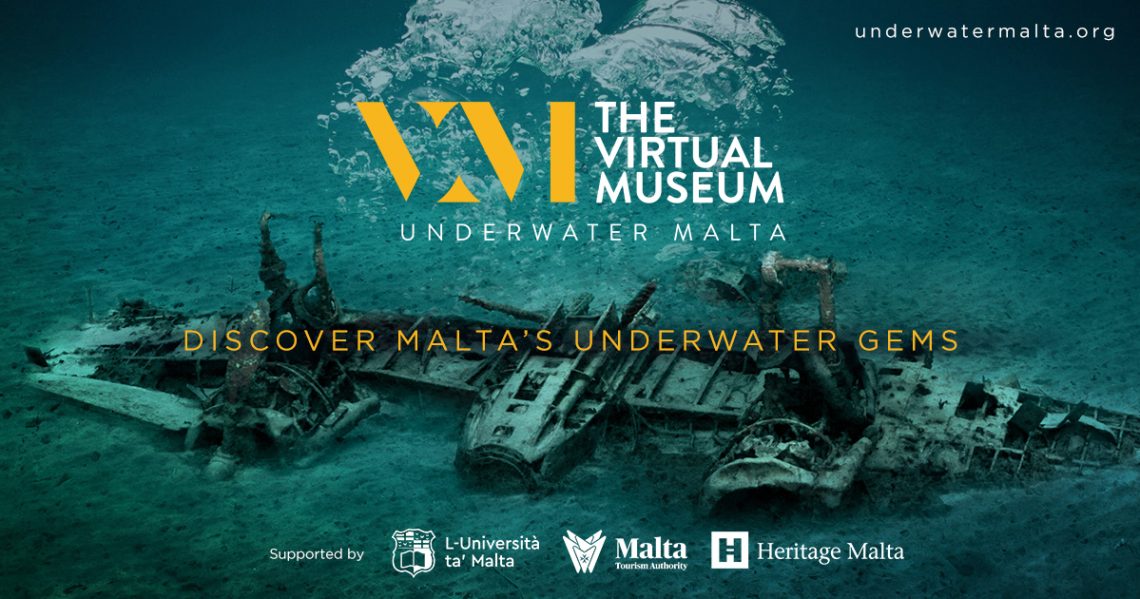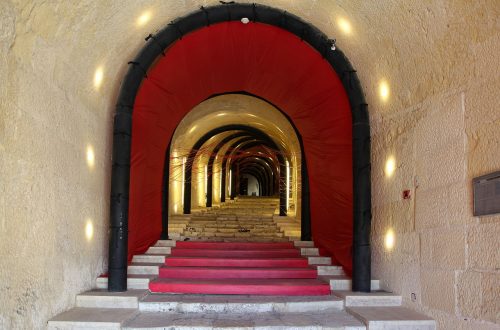
Underwater Malta – Virtual Museum: an innovative and state-of-the-art public access strategy for underwater heritage (Nationwide, Malta)
Given Malta’s strategic location at the center of the Mediterranean, the seafloor surrounding the island holds hidden heritage from almost every period of history, including a 2700-year-old Phoenecian shipwreck, ships, planes, and submarines. Thanks to cross-disciplinary collaboration and advances in technology, in June 2020 a virtual museum was launched (first of its kind in the Mediterranean) making this hidden heritage accessible. Using 3D modeling, virtual reality, and other media, the website aims to provide access to and share Malta’s unique underwater cultural heritage with all members of the public, to create a digital record to help preserve and protect Malta’s submerged cultural heritage, and to promote and stimulate responsible diving in what is already one of the world’s top diving sites.
Background
The Underwater Malta – Virtual Museum project emerged through years of interdisciplinary collaboration between partners from academia, government, and the local diving industry. The project organizers are the University of Malta’s Department of Classics and Archeology, together with the Underwater Cultural Heritage Unit of Heritage Malta (the national heritage agency). The Malta Tourism Authority contributes financial support, and local diving schools and clubs participate in occasional clean-ups, and lead tourists on responsible diving expeditions to some of the sites.
As a strategic crossroads in the center of the Mediterranean, the Maltese islands have the highest density of World Heritage sites per square kilometre anywhere in the world. Meanwhile, Malta’s underwater archaeology has remained relatively out of sight and out of mind, which has also helped preserve it. For almost two decades, the University of Malta has been conducting systematic underwater research off the coasts of Malta and Gozo, resulting in such finds as the 2015 discovery of the oldest shipwreck in the central Mediterranean. At the same time, Malta is emerging as one of the world’s top diving sites; in 2019 an estimated 130,000 people visited Malta specifically to take part in diving activities. In 2019, growing recognition of this heritage and its associated threats and opportunities led to the creation of a new “Underwater Cultural Heritage Unit” within Heritage Malta, the country’s national heritage agency. Prof.Timmy Gambin, professor of Maritime Archaeology at the University of Malta, was appointed to lead the new unit. The virtual museum opened in June 2020, offering the public a new heritage experience during a period when the Coronavirus pandemic limited access to many touristic sites. With the project in place, in March 2021 Malta was able to ratify the UNESCO Convention on the Protection of Underwater Cultural Heritage, a set of regulations and standards that Malta must adhere to concerning management, protection, and education related to its underwater heritage.
Description
The Underwater Malta – Virtual Museum is the culmination of a systematic process for the management of Malta’s Underwater heritage. The typical process for the recording of the underwater artifacts involves four stages: (1) remote sensing surveys, (2) diver surveys (3) computer processing, and (4) public sharing.
The first step involves conducting a broad survey of the seabed surrounding the Maltese Islands. “Remote sensing” refers to the use of robotics, controlled from a boat on the surface, to collect large amounts of information in a short time, often at depths that are not easily accessible to divers. When this data is integrated with existing records and analysed, anomalies are encountered, such as potential shipwrecks – and once a target is marked, a dive is planned to generate higher-resolution data. Diver surveys typically involve a team of 3 divers (a cameraperson, a light operator, and safety diver) descending into the depths using re-breather technology. There, the site is illuminated with powerful lights and systematically captured using high-definition video. In the third stage, through a process called photogrammetry, the high-definition 4D video footage is processed to generate very high-quality 3D models of the site. Finally, the documentation is uploaded to the virtual museum website. Each site is described and documented in detail, through photographs, video, and 3D models that can be explored through virtual reality. For conservators, the 3D models also serve as benchmarks against which to compare later images of the site, to assess the impacts of climate change and/or human impacts.
The virtual museum website identifies a project team of 24, including a core team of 9 who are both accomplished divers and also technical experts in maritime archaeology, photogrammetry, and/or IT. Other collaborators include a support staff of 8 other divers, 4 on-boat support staff, and 2 technical experts in photogrammetry and 3D visualization. Beyond this, the Heritage Malta’s Underwater Cultural Heritage Unit is responsible for further marketing and promotion of the virtual museum. The Malta Tourism Authority funded the project with an investment of €100,000 over three years. A user-friendly online booking system has also been developed in coordination with local dive schools and clubs, to permit controlled visits to specific underwater sites. Local dive clubs have also helped rid some sites of old nets. Ultimately, the UnderwaterMalta project contributes towards developing the island as a niche market of technical divers, who can physically access the sites through a responsible, managed approach.
Impact
UnderwaterMalta was designed as a public outreach tool: a platform through which Malta’s Underwater cultural heritage is made visible. Since it launched in late June 2020, the virtual museum has received just over 40,000 virtual visitors from across the world. The initial focus was on attracting local visitors, through local newspaper reports and social media posts. The results of this were reflected in early visitor numbers, where the majority of visitors came from Malta. Following this initial stage, a broader global audience was pursued, by publishing editorials in international magazines focused on themes such as diving, travel, culture, history, and archaeology. Ongoing tracking of visitor numbers show that spikes in visitor numbers coincide with the publication of articles in international magazines, the launch of new sites on the platform, and the creation (in November 2020) of social media accounts for the virtual museum. An analysis of visitor numbers six months after opening reflected a shift to an 85% international audience, with the top four visitor origins being UK (31%), USA (27%), Malta (15%), and Germany (13%).
Underwater Malta has launched a new and growing awareness of and appreciation for Malta’s Underwater Cultural Heritage. This is leading to impacts on tourism, heritage research, heritage protection, and education.
Malta Tourism Authority’s investment in the project reflects the potential it sees that Underwater Cultural Heritage will emerge as an important addition to the country’s tourism product. Through the creation of the Underwater Cultural Heritage Unit, Heritage Malta recognized the importance of treating submerged sites with the same importance as those on land. Two years later, a new Digitization Department was created within the same building, to support digitization efforts related to all of Heritage Malta’s properties and collections. Since Underwater Malta first opened, new underwater sites continue to be documented and added to the site, and increased awareness of Malta’s underwater heritage helps protect it, through benchmarking, patrolling, training diving clubs in responsible practices, and controlling access to dive sites.
Going forward, Underwater Malta seeks to continue adapting to new and emerging formats and platforms. Plans are in place to test the use of VR headsets and 360 videos as outreach tools, with the aim of ultimately integrating these digital technologies into the school curriculum together with short explanatory lectures. The whole project is well described in two papers by Gambin et al (2021).
Interpretation
The Underwater Malta – Virtual Museum is an example of the valorization of otherwise invisible cultural heritage, for the benefit of tourism, scientific research, heritage appreciation, and education. The project required collaboration across sectors and disciplines, balancing scientific research, heritage protection, and the promotion of responsible access to underwater cultural heritage sites. It also involved strengthening relationships between the tourism and heritage sectors on the one hand and the maritime and diving communities on the other hand. Through its use of digital technology and its collaborative approach, it is part of a larger effort using digitization to innovate new approaches to Malta’s cultural heritage.
References
- Gambin, Timmy, Kari Hyttinen, Maja Sausmekat, and John Wood. 2021. “Making the Invisible Visible: Underwater Malta—A Virtual Museum for Submerged Cultural Heritage” Remote Sensing 13, no. 8: 1558. https://doi.org/10.3390/rs13081558
- Gambin, Timmy, Maja Sausmekat, and Darko Kovacevic. 2021. “The Innovative and State of the Art Public Access Management of Malta’s Underwater Cultural Heritage” Heritage 4, no. 4: 3365-3381. https://doi.org/10.3390/heritage4040187
- Underwater Malta – The Virtual Museum, “About – The Virtual Museum”, https://underwatermalta.org/about/ (accessed Oct 1, 2021).
- UM Newspoint (2021, March 1), “Dive deep into underwater Malta, in 3D”, https://www.um.edu.mt/newspoint/news/2021/03/dive-deep-underwater (accessed Nov 2, 2021).
- Galea DeBono, Fiona., “Malta to take a deeper dive into its underwater heritage”, Times of Malta, July 25,2021. https://timesofmalta.com/articles/view/malta-to-take-a-deeper-dive-into-its-underwater-heritage.888925
Author
Header photograph
Photo




